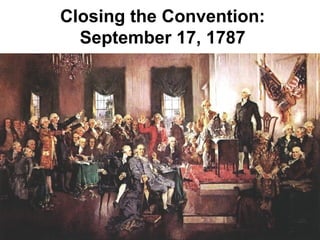
Constitutional Convention Closes as Delegates Agree to Constitution
- 1. Closing the Convention: September 17, 1787
- 2. Framers at the Constitutional Convention debated and discussed the issues of representation, population counts and who should get to vote, among other things. Now that a Constitution has been agreed to and signed by 39 of the remaining 42 delegates (55 original, 13 went home and 3 refused to sign, citing that the new Constitution gave too much power to the national government), the Constitution must be ratified by each of the states.
- 3. Federalism • A system of govt in which power is divided between the national (central, federal) govt and state governments. The federal govt is SUPREME.
- 4. 1. The framers designed a republic (p. 198) • A form of government where people (citizens) rule through elected representatives.
- 5. 2. The framers were inspired by the British Government(p. 198-199): • Magna Carta: Written document limiting power of the ruler and forcing the ruler to obey the law (≈ U.S. Constitution) • Parliament: People elected to make laws (≈ Congress) • English Bill of Rights: Rights to the people limiting monarchy and protecting rights of citizens (≈ Bill of Rights—first 10 amendments of the Constitution)
- 6. The framers were inspired by the Greeks and Romans (notes only) • Greeks in Athens had a direct democracy—citizens voted directly for their laws. • Roman Republic had a three-branch government (U.S. Senate ≈ Roman Senate, U.S. Executive ≈ Roman Consuls, U.S. Supreme Court ≈ Roman Praetors)
- 7. 4. The framers were inspired by American Experiences: • Virginia House of Burgesses: representative government established in 1619 • Mayflower Compact: 1620: Compact of self-government with which the people agreed to “combine themselves together into a civil body politic” in order to establish “just and equal laws” • Pre-Revolutionary experiments: Second Continental Congress, The Articles of Confederation, and their own state governments.
- 8. 5. The framers were inspired by Enlightenment thinkers: • John Locke: Two Treatises on Government – Natural rights to life, liberty and property. – Government is to protect these rights. If not, people must rebel. • Baron de Montesquieu: The Spirit of the Laws – How to organize government to keep anyone from taking too much power • Separation of Powers: 3 branches of government • Rules of law: government powers should be clearly defined to ensure that everyone is doing his/her job and that each branch has equal power.
- 9. In summary, the framers set out the basic laws of the new nation, defining and limiting government’s powers.
- 10. Issue 1—Representation in Congress (the legislative branch) • Larger states wanted population-based, or proportional representation. Smaller states wanted equal representation for all states, so that they wouldn’t be overrun by large states.
- 11. The Virginia Plan, proposed by Edmund Randolph and James Madison of Virginia, called for three branches of government, with a legislative branch comprised of 2 houses, both based on population, so that larger states would have more representatives in Congress than smaller states.
- 12. The New Jersey Plan, proposed by William Paterson of NJ, also called for three branches of government and for a legislature with one house and every state would get one vote, regardless of population. NJ PLAN 1 state=1 vote
- 13. The Great Compromise, approved on July 16, was made by Roger Sherman of Connecticut, who called for a 2-house legislature. The lower house, the House of Representatives, would be population based. The upper house, the Senate, would have 2 senators per state, no matter what state.
- 14. Issue 2—Which People Should Count Towards a States’ Population Totals? •Northern states didn’t have as many slaves and were slowly fazing slavery out. •Southern states were becoming increasingly dependent on slaves and were importing more and more slaves in each day. •Should slaves be counted as part of a state’s population, even though they couldn’t vote and had no rights? •If allowed to count, the Southern states would have many more votes in Congress than the Northern states.
- 15. Three-Fifths Compromise —3/5 of the slaves in a state would count toward the population. For every 5000 slaves, 3000 would count as population.
